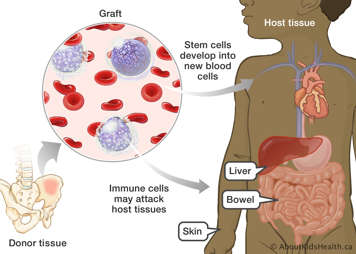After an allogeneic blood and marrow transplant (BMT), some children may develop a complication called graft vs host disease (GVHD). When GVHD develops later after the transplant, it is called chronic GVHD. It can affect many organs and causing life-long scarring (for example, on the skin).
GVHD occurs when the new bone marrow stem cells, called the graft, recognize your child (the host) as different from what they expect. The graft contains donor white blood cells called lymphocytes, which distinguish between cells that belong in the body and those that do not. During GVHD, the graft sends out lymphocytes to attack your child’s organs and tissues. The new stem cells can damage organs such as the liver, skin, or bowel.
Receiving stem cells from an unrelated or mismatched HLA donor increases your child’s chances of developing GVHD. Also, children who developed GVHD soon after the transplant (within three months) are at a greater risk of developing chronic GVHD.
While coping with GVHD can be upsetting, most children survive without facing permanent long-term side effects.

Symptoms of chronic GVHD
Some of the more common signs of chronic GVHD affect different parts of the body, such as:
- dryness of eyes, with increased tearing and redness
- dryness of mouth, with ulcers or sores and changes in taste
- areas of decreased and increased colour, scarring and thickness on the skin (this can cause tightness across joints)
- changes in appetite, frequent loose stools, and unable to gain weight
Other symptoms include:
- skin rash, usually starts on the palms or feet but may be on the chest or back.
- in severe cases, the rash may spread to other parts of the body and become redder in colour (similar to sunburn)
- diarrhea
- yellowing of the skin and eyes (jaundice)
- mild liver tenderness
- increased amounts of a yellow substance the body normally excretes, called bilirubin. (The body gets rid of bilirubin through a fluid excreted by the liver, called bile. When there are high levels of bilirubin in the body, the bile is not working properly.)
If you notice any early signs of GVHD, tell your child’s transplant physician as soon as you can. This way, they can start giving your child appropriate treatment right away.
Treating GVHD
Children who develop GVHD usually take a combination of medicines. Chronic GVHD often starts more slowly and takes longer to respond to treatment. Since some of these medicines also prevent GVHD, your child may be given these medicines prior to the transplant. The doctor may increase the dose if your child develops GVHD after her transplant.
Prednisone
Prednisone helps treat and prevent GVHD by weakening your child’s new immune system. This way, the new immune system has more time to get used to and tolerate your child’s body. These types of drugs are called immunosuppressants. A healthy immune system fights off cells that do not belong in the body, such as bacteria and other tissue it does not recognize. The goal is for your new immune system (transplant) to accept your body, not attack it. This is why prednisone is the first type of drug doctor’s use to treat your child’s GVHD.
Your child may need to use prednisone for a long period of time, depending on the severity of the GVHD.
Cyclosporine
Similar to prednisone, cyclosporine is an immunosuppressant. It both prevents and treats GVHD. All children who receive stem cells or bone marrow from a donor will start on cyclosporine before their transplant date. During the transplant period, the doctor needs to make sure your child is receiving an adequate amount of cyclosporine. They will check the level of cyclosporine in your child’s blood periodically.
Your child continues to take cyclosporine for about six months after the transplant. After being discharged from the hospital, a nurse will check your child’s cyclosporine levels every week.
Methotrexate
Methotrexate stops the cells from dividing and making new cells. Methotrexate is used to prevent graft vs host disease (GVHD) following bone marrow or stem cell transplant. Children who receive stem cells or bone marrow from a donor may receive three or four doses of a methotrexate. Since this medicine may cause mouth sores, good mouth care is very important.
For more information, please see the page on Daily Care.
Depending on your child’s response to the first medication, doctors may need to use other medicines to control chronic GVHD. For example, while being treated for chronic GVHD, your child may be given antibiotics to reduce the risk of infection.
Until your child’s GVHD is completely treated and she no longer needs immunosuppressive drugs, your child should avoid:
- crowds
- fresh fruits, vegetables, and plants
- live vaccinations such as chicken pox, measles, mumps, and rubella
- exposure to chicken pox
Problems gaining weight
Children that develop chronic GVHD may have difficulty gaining weight. Your child’s health care team, including the dietitian, will follow their weight closely. Your child may need to undergo tests to understand why they are having difficulty gaining weight and in some instances special formulas will need to be used to help provide enough nutrition.